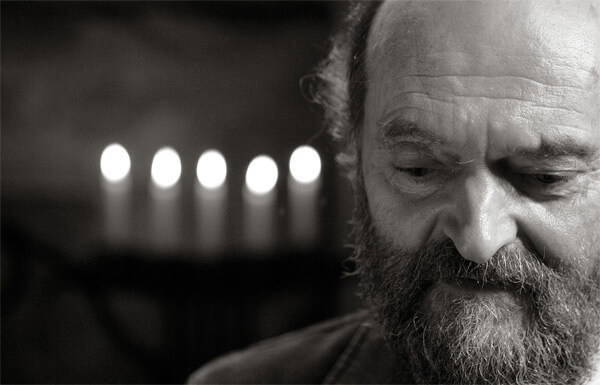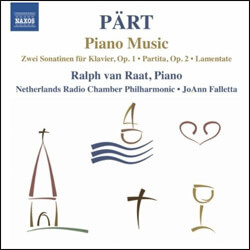
The first of the Zwei Sonatinen, Op. 1 (1958), shares much of the language of Pärt’s elder contemporary, Shostakovich, with acrobatic melodies supported by harmonies that become only occasionally dissonant, and then only through linear voice-leading. Ralph van Raat plays the allegro passages with a digital precision characteristic of post-war piano music. He imbues the largo passages, though, with a touching impressionistic quality. The second sonatina (1959) is quite another animal, with a jazzy improvisatory feel, recalling the dizzying flights of Oscar Peterson.

Arvo Pärt - Photograph by K. Kikkas
The movements the Partita, Op. 2 (1959), recall baroque forms (Toccatina, Fughetta, Larghetto, Ostinato), but the musical language is decidedly modern, the first two movements charging aggressively up and down the keyboard, and making full use of pitch material while not being constricted by serial techniques. The third movement is a study of chords, growing in complexity and dynamics and adhering to a touching, Schubertian dotted triple meter.
I found the engineering on these Op.1-2 recordings a bit sterile; there is something synthetic about a too-pure, close-up piano sound robbed of the reverb of a natural space. This was evidently adjusted for the Variationen zur Gesundung von Arinuschka (1977), influenced by early music and the heavenly notes of which are allowed to decay without haste in Amsterdam’s Haitinkzaal, where van Raat recorded these solo piano pieces. The first three variations begin with the same doleful notes of a minor triad, while the last three are “healed” and presented in the major mode, hinting at a successful Gesundung, or recovery. The guileless simplicity of these diatonic tone-studies enables a very close identification between composer, performer, instrument, and audience, the very essence of effective music.
Für Alina showcases the composer’s use of bell-like sounds, or ‘tintinnabuli.’ The listener perceives two musical lines, which while engaged in a slow, steady dance, never quite embrace each other. Estrangement and longing coexist, balanced on pregnant pauses and the decay of pure bell-tones.

There are many contemporary composers who receive coveted commissions, only to see their creations shelved after one performance. Arvo Pärt is that rare living artist who has managed to penetrate the finicky audiences of today and present them with something unmistakably universal. His expressiveness is rooted in artistic humility, but with patience and focus, the listener is rewarded with an experience altogether sublime.
Piano Music, Arvo Pärt, Netherlands Radio Chamber Philharmonic, Ralph Van Raat, Cond. Joann Falletta (Naxos, 2011) – Buy on Amazon
—
Rob Wendt is a pianist / composer / music educator living in Astoria, NY. You can follow him on twitter: @RobWendt
